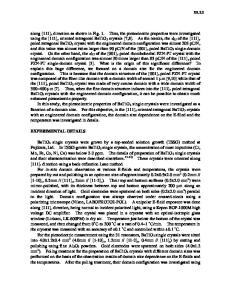Visual and Quantitative Characterization of Ferroelectric Crystals and Related Domain Engineering Processes by Interfero
Nonlinear crystals are, nowadays, key devices to build coherent sources emitting radiation from the UV to the IR spectral range. Applications of nonlinear optics are primarily based on frequency conversion, through harmonic generation or sum and differenc
- PDF / 3,252,665 Bytes
- 42 Pages / 441 x 666 pts Page_size
- 52 Downloads / 267 Views
Visual and Quantitative Characterization of Ferroelectric Crystals and Related Domain Engineering Processes by Interferometric Techniques P. Ferraro, S. Grilli, M. Paturzo, and S. De Nicola
7.1 Introduction Nonlinear crystals are, nowadays, key devices to build coherent sources emitting radiation from the UV to the IR spectral range [1]. Applications of nonlinear optics are primarily based on frequency conversion, through harmonic generation or sum and difference frequency mixing. These nonlinear frequency conversion techniques make possible coherent light sources in spectral regions where laser sources are limited, or do not exist. Light sources based on nonlinear crystals, like optical parametric oscillators as well as harmonic and difference frequency generators, are finding increasing application in high sensitivity spectroscopy [2–4]. It has to be outlined that recent results obtained in micromachining and engineering at micrometric and nanometric level of ferroelectric materials and in particular of lithium niobate (LN or LiNbO3 ) makes strategic the accurate knowledge and characterization of the optical ferroelectric materials with aim at realizing and fabricating micro-optical devices. On the other hand it is important to have reliable fabrication processes of micro-devices for non-linear or linear applications. Among various methods and techniques adopted to investigate and study the engineering processes a very important role has been played by interferometric techniques. In this chapter we focus the attention on different interferometric approaches that have been adopted for characterizing the materials and engineering processes. In Sect. 7.3.1 are described method for measuring refractive index. Section 7.3.2 will be devoted to method allowing the visualization and study of the kinetics of domain formation in ferroelectric crystals during the electric filed poling (EFP). In Sect. 7.3.3 will be illustrated how through a digital holographic (DH) technique it is possible to obtain a 2D mapping of the electro-optic coefficient in standard wafers and how it i s possible investigate the internal electric field. Finally, Sect. 7.3.3 P. Ferraro (B) · S. Grilli · M. Paturzo · S. De Nicola Istituto Nazionale di Ottica del CNR (CNR-INO), Pozzuoli, Napoli, Italy e-mail: [email protected] P. Ferraro et al. (eds.), Ferroelectric Crystals for Photonic Applications, Springer Series in Materials Science 91, DOI 10.1007/978-3-642-41086-4_7, © Springer-Verlag Berlin Heidelberg 2014
163
164
P. Ferraro et al.
is instead dedicated to the investigation of the optical birefringence near the wall between two opposite domains in a z-cut congruent LiNbO3 through a full-field polarimetric method.
7.2 Measuring the Refractive Indices and Thickness of Lithium Niobate Wafers In electro-optic crystal materials, the index of refraction can be controlled by changing an electric field across the material. Many materials exhibit a small EO effect including quartz; however, the EO materials with the largest EO effect that are co
Data Loading...











